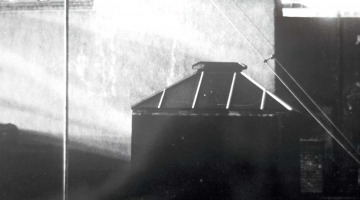
Man with a moustache and dark glasses holding a water bottle (2013)
Silkscreen on painted wooden board
98.6 x 45.2 cm
Courtesy of the artist and Valentina Bonomo, Rome
The digital being called the ‘avatar’ is a concept non-exclusive to the technological realm. It doesn’t even belong to the modern world. The Hindu word ‘avatar’ refers to the descent of a deity to Earth as an appearance or manifestation. Whatever the qualities of that avatar, not all of its traits are immediately perceivable to the human eye or mind; a chasm between sight and knowledge transpires when an idea transubstantiates in reverse. This communication breakdown is a mere facet of Julian Opie’s long and successful practice. Over three decades as an artist, Opie has witnessed and interpreted the rapid growth of computer technology in its seemingly relentless drive to emulate and enhance human activity. He has drawn from Minimalism and Pop in reducing the subjects of his portraits and landscapes to their bare essences: their shades and shadows are solid, their personalities barely cut through the thick blocks of uniform pixel fields. From the simplest forms rendered on obsolete imaging programs to high-definition LCD screens mimicking steady walks through public space, he has joined artists such as Close, Katz and Warhol in shaping a new frontier of visual language using the face, itself, as a medium. The 55-year old Briton has paved a route for younger practitioners such as Cory Arcangel and Ryan Trecartin, who shift conversations about digital technology from theory into active and reactive measures.
In the heart of the Old Jewish Ghetto in Rome, respected gallerist Valentina Bonomo mounted a review of Opie’s recent work. It’s quaint that an exhibition dealing with questions of a technological future is situated entirely in a city built (and still surviving) thanks to the treasures of the past. Within the larger realm of his practice, the works haven’t changed drastically in the last two decades. Opie still retains a fascination with the human form rendered as anonymous, stripped down to become nearly featureless, and even portraits larger than life-size are composed of block lines, solid gradients and pinhole eyes. The smaller works, silkscreen laid onto painted wood planks, reflect richer and more varied color representations than their tondo portrait counterparts: the titles are dry, but the little figures become more approachable thanks to their shimmering jackets and sun-streaked glasses.

Woman with small plastic bag (2013)
Continuous computer animation,
media player and 55” LCD screen
128 x 75 x 7.3 cm
Courtesy of the artist and Valentina Bonomo, Rome
A panel depicting a large woman carrying a plastic bag, walking (naturally), is rendered as an LCD animation loop. We would imagine a woman matching her gait and weight would tire out quickly and be distracted easily because of her exertions. But she walks steadily, without pause or lowering her head: her constant movement is a contradiction of our prejudices and expectations. This is another brilliant jab at judgments. The subject retains its invisibility, its audience never tires of blind criticisms, and yet the essential form persists.
If Opie’s new work offers anything new, it is this single animated screen that pushes the aesthetic dialogue forward: what we see belies what actually is. Our presence in the tangible realm is connected with razor-thin threads to our digital manifestations, we can only filter so much of our infinitely intricate selves into a finite set of codes.
For more information on Julian Opie visit Galleria Valentina Bonomo Rome, Italy.
-Contributed by Shana Beth Mason


